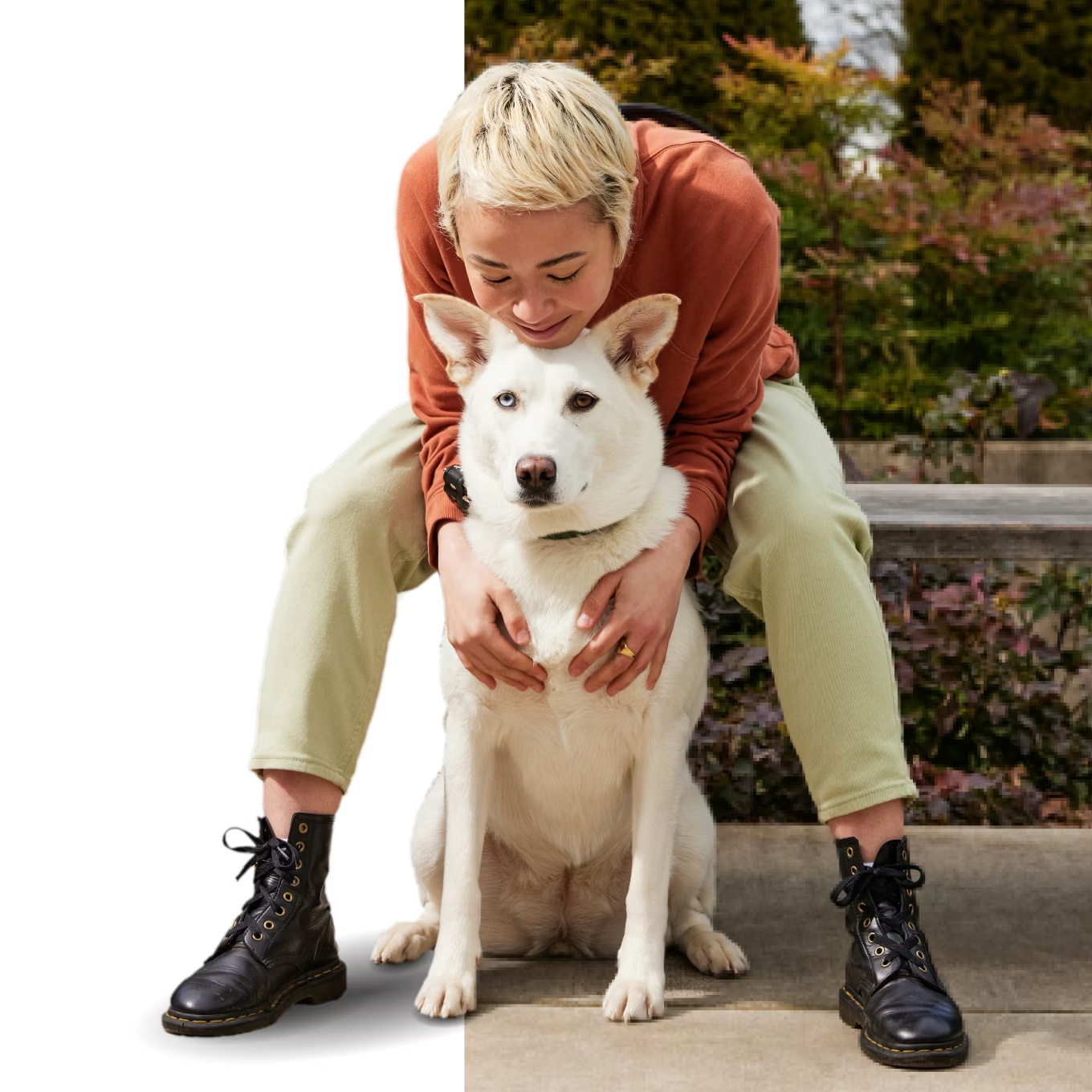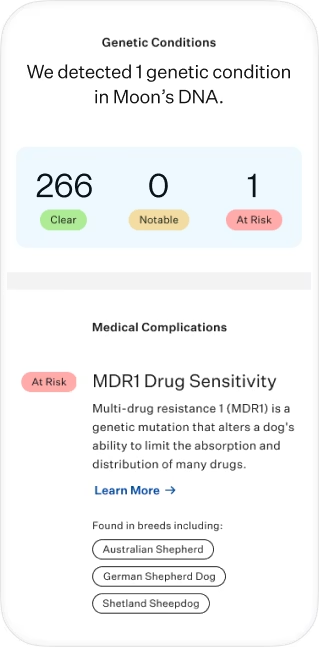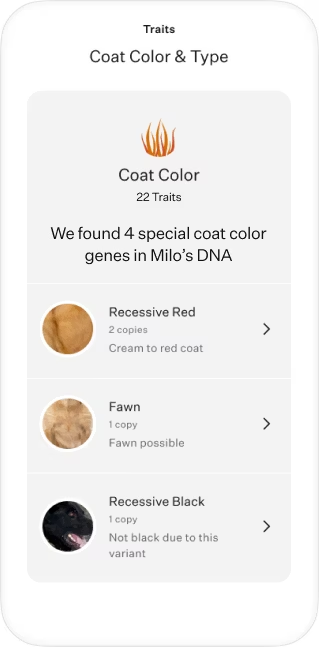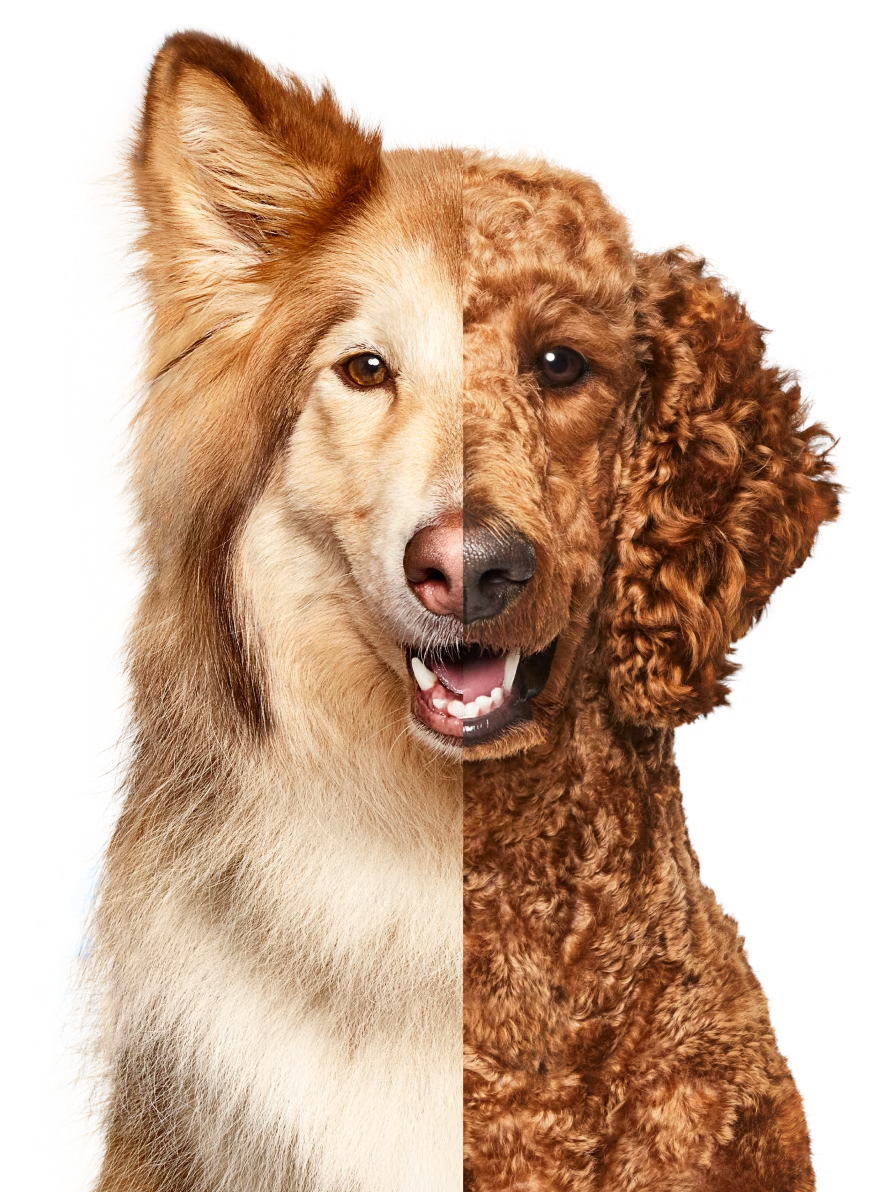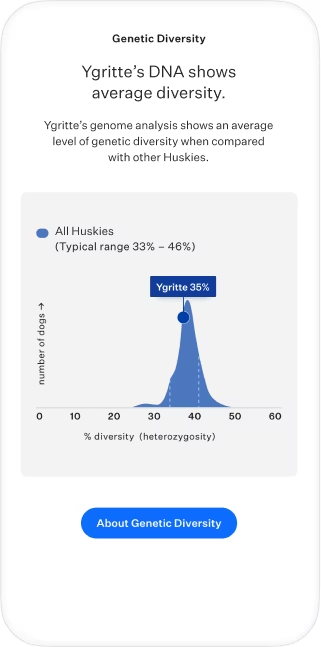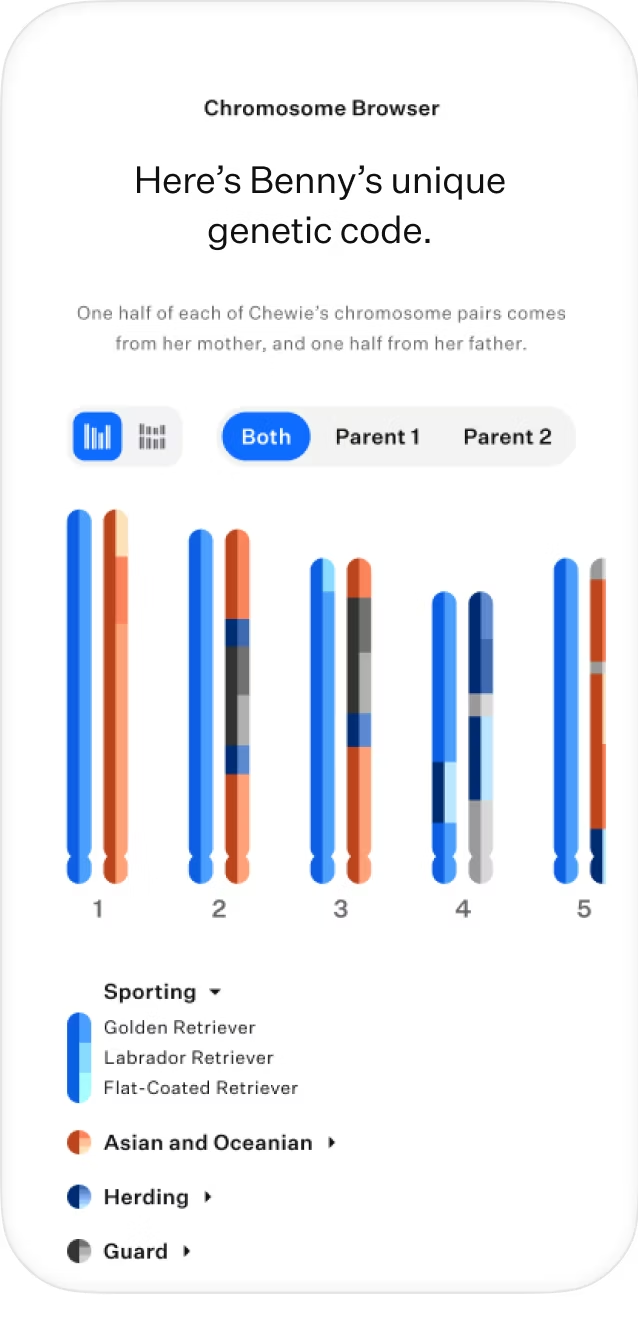Wisdom Panel Premium has over 265+ tests for health conditions
Health tests included in all Wisdom Panel Premium kits
2,8-dihydroxyadenine (DHA) Urolithiasis
2,8-dihydroxyadenine (DHA) urolithiasis is a genetic disorder caused by a mutation in the APRT gene. A defective APRT enzyme can result in the formation of 2,8-dihydroxyadenine (DHA) urinary stones which can lead to urinary tract obstruction.
Acral Mutilation Syndrome
Acral Mutilation Syndrome (AMS) causes insensitivity to pain, leading to a tendency to lick or bite paws excessively. This often results in loss of toenails, fractures, and toe amputation.
Acute Respiratory Distress Syndrome
Acute respiratory distress syndrome (ARDS) is a rare, life-threatening disorder that causes a rapid severe respiratory failure that is unresponsive to treatment.
Alaskan Husky Encephalopathy
Alaskan Husky Encephalopathy (AHE) is a severe, early-onset disorder of the nervous system that causes wide-ranging clinical signs, including seizures, behavioral changes, and incoordination.
Alexander Disease
Alexander disease is a rare, fatal neurological disease, causing progressive weakness in all limbs.
Amelogenesis Imperfecta (Discovered in the Lancashire Heeler)
Amelogenesis Imperfecta (AI), also known as enamel hypoplasia, is a disorder where the hard enamel covering of the teeth is thin, roughened, and discolored. Please note, the genetic variant tested by Wisdom is currently under research for association of AI in the Lancashire Heeler with a scientific manuscript in preparation.
Bandera's Neonatal Ataxia
Bandera's Neonatal Ataxia (BNA), discovered in the Coton de Tulear, is a severe brain problem that affects a puppy's ability to move its body properly.
Bernard-Soulier Syndrome (Discovered in the Cocker Spaniel)
Bernard-Soulier Syndrome (BSS) is a bleeding disorder in which platelets cannot bind together normally, leading to delayed blood clotting. The condition is characterized by larger than normal platelets and variably low platelet numbers, known as macrothrombocytopenia. The associated genetic variant has been identified in the Cocker Spaniel.
Canine Multifocal Retinopathy 1
Canine Multifocal Retinopathy 1 (CMR1) is an eye disorder that can cause retinal decay which may impact vision, but very rarely results in blindness.
Canine Multifocal Retinopathy 2
Canine Multifocal Retinopathy 2 (CMR2) is an eye disorder that can cause retinal decay which may impact vision, but very rarely results in blindness.
Canine Multifocal Retinopathy 3
Canine Multifocal Retinopathy 3 (CMR3) is an eye disorder that can cause retinal decay which may impact vision, but very rarely results in blindness.
Canine Scott Syndrome
Canine Scott Syndrome (CSS) is a bleeding disorder caused by a hereditary defect affecting blood platelets, which are important in the blood clotting process. This means that clots form more slowly at a site of bleeding.
Cerebellar Ataxia
Cerebellar Ataxias (CAs) are a group of disorders in which there is a degeneration in the movement center of the brain, known as the cerebellum. The degeneration leads to a lack of coordination in movements.
Cerebellar Hypoplasia
Cerebellar Hypoplasia (CH) causes difficulty controlling bodily movements (ataxia). The severity of the ataxia can vary between affected dogs and does not worsen with age.
Cerebral Dysfunction
Cerebral Dysfunction is a brain disorder that causes affected puppies to show severe mental depression, odd behaviors, and limb weakness.
Cleft Lip & Palate with Syndactyly
Cleft Lip & Palate with Syndactyly (CLPS) is a disorder that causes an abnormal hole in the roof of the mouth (cleft palate), a hole between the lip and the nose (cleft lip), and joined toes.
Cleft Palate
Cleft Palate (CP) a disorder that causes an abnormal hole in the roof (palate) of the mouth. Puppies with this condition can also have a smaller than normal lower jaw bone.
Complement 3 Deficiency
Complement 3 Deficiency (C3D) is a disease that causes severe immunodeficiency, leaving affected dogs vulnerable to infections.
Cone-Rod Dystrophy
Cone-Rod Dystrophy (CRD) is an eye disorder resulting in degeneration of the retina at the back of the eye at a young age, causing progressive vision loss.
Cone-Rod Dystrophy 1
Cone-Rod Dystrophy (CRD1) is an eye disorder resulting in degeneration of the retina at the back of the eye at a young age, causing progressive vision loss.
Cone-Rod Dystrophy 2
Cone-Rod Dystrophy (CRD2) is an eye disorder resulting in degeneration of the retina at the back of the eye at a young age, causing progressive vision loss.
Congenital Cornification (Discovered in the Labrador Retriever)
Congenital Cornification is a rare X-linked dominant skin disorder. Affected females with one copy of the variant have shown striped, symmetrical thickening of the skin and paw pads, lameness associated with paw pad lesions, and stunted growth. The variant is thought to be lethal in affected males and, possibly, females with two copies. The associated genetic variant has been identified in the Labrador Retriever.
Congenital Muscular Dystrophy (Discovered in the Italian Greyhound)
Congenital Muscular Dystrophy (CMD) is a progressive muscular disorder characterized by muscle wasting, formation of excess connective tissue in the muscles, and possibly abnormal nerve conduction. The associated genetic variant has been identified in the Italian Greyhound.
Craniomandibular Osteopathy (Discovered in the Australian Terrier)
Craniomandibular Osteopathy (CMO), also known as "lion's jaw," is a disorder of bone growth, with bones of the skull most consistently affected. During the growth period, the jaw bones become swollen and thickened, causing pain, drooling, and difficulty eating. The associated genetic variant has been identified in the Australian Terrier.
Craniomandibular Osteopathy (Discovered in the Basset Hound)
Craniomandibular Osteopathy (CMO), also known as "lion's jaw," is a disorder of bone growth, with bones of the skull most consistently affected. During the growth period, the jaw bones become swollen and thickened, causing pain, drooling, and difficulty eating. The associated genetic variant has been identified in the Basset Hound.
Craniomandibular Osteopathy (Discovered in the Weimaraner)
Craniomandibular Osteopathy (CMO), also known as "lion's jaw," is a disorder of bone growth, with bones of the skull most consistently affected. During the growth period, the jaw bones become swollen and thickened, causing pain, drooling, and difficulty eating. The associated genetic variant has been identified in the Weimaraner.
Cystinuria Type I-A
Dogs with Cystinuria are not able to reabsorb the amino acid cystine in their kidneys and therefore high concentrations can accumulate in the urinary tract resulting in formation of cystine crystals and stones that can cause obstruction.
Cystinuria Type II-A
Dogs with Cystinuria are not able to reabsorb the amino acid cystine in their kidneys and therefore high concentrations can accumulate in the urinary tract resulting in formation of cystine crystals and stones that can cause obstruction.
Darier Disease (Discovered in the Irish Terrier)
Darier Disease is a skin disorder characterized by cysts forming in the skin or ear canals that can be covered by ulcerative lesions. The associated genetic variant has been identified in the Irish Terrier.
Degenerative Myelopathy
Degenerative Myelopathy (DM) is a neurological disorder, usually affecting dogs in their senior years. Loss of hind limb coordination is an early sign of disease, and as the condition progresses the hind limbs of affected dogs become increasingly weak.
Demyelinating Neuropathy
Demyelinating Neuropathy is a progressive neurodegenerative disease, causing noisy breathing, regurgitation and mild exercise intolerance.
Dental Hypomineralization
Dental Hypomineralization is a disease that causes abnormal mineralization of the teeth, resulting in a brownish discoloration and abnormal wear of the teeth.
Disproportionate Dwarfism (Discovered in the Dogo Argentino)
Disproportionate Dwarfism is a disorder that affects bone and cartilage development, leading to changes in limb length and conformation, body length and height, and head shape. The associated genetic variant has been identified in the Dogo Argentino.
Early-Onset Progressive Retinal Atrophy, (Discovered in the Spanish Water Dog)
Early-Onset Progressive Retinal Atrophy (EOPRA) is an eye disorder where the light sensing retina at the back of the eye deteriorates, causing impaired vision. The associated genetic variant has been identified in the Spanish Water Dog, and affected dogs are typically diagnosed with progressive vision loss before 4 years of age.
Ehlers-Danlos Syndrome (Discovered in mixed breed)
Ehlers-Danlos Syndrome (EDS) is an inherited connective tissue disorder characterized by skin that is easily stretched, fragile, and easy to bruise, as well as increased flexibility of joints. The associated genetic variant has been identified in mixed breed dogs.
Ehlers-Danlos Syndrome (Discovered in the Labrador Retriever)
Ehlers-Danlos Syndrome (EDS) is an inherited connective tissue disorder characterized by skin that is easily stretched, fragile, and easy to bruise, as well as increased flexibility of joints. The associated genetic variant has been identified in the Labrador Retriever.
Epidermolytic Hyperkeratosis
Epidermolytic Hyperkeratosis is a skin disorder that causes the skin to be fragile and easily damaged from birth followed by thickening of the skin in adulthood.
Episodic Falling Syndrome
Episodic Falling Syndrome (EFS) is a condition causing the temporary inability to relax muscles resulting in collapse episodes which are usually a few seconds to several minutes long.
Exercise-Induced Collapse
Exercise-Induced Collapse (EIC) is a neuromuscular disorder which can cause incoordination and weakness, resulting in collapse, after periods of strenuous exercise.
Factor VII Deficiency
Factor VII Deficiency is an inherited blood clotting disorder that results in excessive bleeding occurring after a severe trauma or surgery. The signs of the disease are typically mild but can vary in severity in different affected dogs.
Factor XI Deficiency
Factor XI Deficiency is a hereditary disorder that impacts blood clotting. The disease usually causes a mild, spontaneous bleeding disorder but more severe bleeding may occur following surgery. Many dogs that are at risk will not show any signs of disease.
Fanconi Syndrome
Fanconi Syndrome is a disorder of kidney function. For dogs affected with the syndrome the kidney's ability to reabsorb essential metabolites such as glucose, electrolytes, amino acids, and proteins in the urine, is impaired causing a wide variety of signs including frequent drinking and urinating, weight loss, and poor coat condition.
Fetal Onset Neuroaxonal Dystrophy
Fetal Onset Neuroaxonal Dystrophy (FNAD) is a disorder that disturbs the development of motor (movement) nerves in the central nervous system. Signs include abnormal curvature of the spine and contracted joints. Affected puppies to have no voluntary movement of limbs. Respiratory deficiencies (difficulties breathing) cause affected puppies to die at birth.
Focal Non-Epidermolytic Palmoplantar Keratoderma
Focal Non-Epidermolytic Palmoplantar Keratoderma (FNEPPK) is an inherited skin disorder that causes a type of hereditary footpad hyperkeratosis (HFH). Signs include hard, thickened, and cracked footpads.
Globoid Cell Leukodystrophy (Discovered in Terriers)
Globoid Cell Leukodystrophy (GLD) is a disorder which results in degeneration of the nervous system. GLD is characterized by muscle weakness, tremors, and ataxia (uncoordinated movement). Signs of the disease also include behavioral changes, incoherence, blindness, and deficits in normal reflexes.
Globoid Cell Leukodystrophy (Discovered in the Irish Setter)
Globoid Cell Leukodystrophy (GLD) is a disorder which results in degeneration of the nervous system. GLD is characterized by muscle weakness, tremors, and ataxia (uncoordinated movement). Signs of the disease also include behavioral changes, incoherence, blindness, and deficits in normal reflexes.
GM1 Gangliosidosis (Discovered in the Shiba)
GM1 gangliosidosis is a disorder of progressive nervous system degeneration, resulting in vision impairment, head tremor, involuntary eye movements, limb weakness with difficulties in balancing and fatigue.
Hemophilia A (Discovered in Old English Sheepdog)
Hemophilia A, also known as Factor VIII Deficiency, is a blood clotting disorder, which can cause bruising or abdominal bleeding without apparent reason. The disease is more commonly seen in male dogs.
Hemophilia A (Discovered in the Boxer)
Hemophilia A, also known as Factor VIII Deficiency, is a blood clotting disorder, which can cause bruising or abdominal bleeding without apparent reason. The disease is more commonly seen in male dogs.
Hemophilia A (Discovered in the Havanese)
Hemophilia A, also known as Factor VIII Deficiency, is a blood clotting disorder, which can cause bruising or abdominal bleeding without apparent reason. The disease is more commonly seen in male dogs.
Hemophilia A (Discovered in the Labrador Retriever)
Hemophilia A, also known as Factor VIII Deficiency, is a blood clotting disorder that can cause bruising or abdominal bleeding without apparent reason. The associated genetic variant has been identified in the Labrador Retriever. However, please note that this variant does not explain all occurrences of Hemophilia A in the breed, indicating additional genetic causes remain to be discovered.
Hemophilia B
Hemophilia B, also known as Factor IX Deficiency, is a blood clotting disorder most commonly seen in male dogs, which can result in prolonged bleeding after an injury or a surgical procedure.
Hemophilia B (Discovered in the Lhasa Apso)
Hemophilia B, also known as Factor IX Deficiency, is a blood clotting disorder most commonly seen in male dogs, which can result in prolonged bleeding after an injury or a surgical procedure.
Hereditary Ataxia (Discovered in the Belgian Malinois)
Hereditary Ataxia is a neurologic disorder characterized by uncoordinated movements and partial paralysis of the hindlimbs. Signs usually first develop during puppyhood and are progressive. The associated genetic variant has been identified in the Belgian Malinois.
Hereditary Calcium Oxalate Urolithiasis, Type 1
Hereditary Calcium Oxalate Urolithiasis, Type 1 (CaOx1) is a genetic disorder that greatly increases the risk for urinary stones composed of calcium oxalate to form within the kidneys or bladder.
Hereditary Elliptocytosis
Hereditary Elliptocytosis is a disease where the red blood cells are abnormally oval shape, rather than the characteristic biconcave or dumbbell shape that is normally seen.
Hereditary Footpad Hyperkeratosis
Hereditary Footpad Hyperkeratosis (HFH) is a skin disorder, with disease signs including hard, thickened, and cracked footpads and an abnormal coat.
Hereditary Vitamin D-Resistant Rickets Type II
Hereditary Vitamin D-Resistant Rickets (HVDRR) is a bone defect where vitamin D cannot be delivered to the bones effectively. This prevents normal bone mineralization, leading to softening and bending of the bones and skeletal problems.
Hyperuricosuria
Hyperuricosuria (HUU) is a condition that predisposes affected dogs to the formation of urinary stones, such as kidney or bladder stones.
Hypocatalasia
Hypocatalasia is the deficiency of an enzyme called catalase in red blood cells. The catalase enzyme plays an important role in the cells defense against a type of chemical damage, known as oxidative damage. The disorder is characterized by ulcers and progressive gangrene (tissue death) of the mouth.
Hypomyelination
Hypomyelination is a neurological disorder causing muscle tremors and movement difficulties.
Hypophosphatasia
This early onset condition originally discovered in Karelian Bear Dogs is a metabolic bone disease that disturbs skeletal mineralization.
Ichthyosis (Discovered in the Great Dane)
Ichthyoses is a disease of skin cornification. This particular mutation causes severe thickening, drying and scaling of the skin, which can lead to secondary infections.
Intestinal Cobalamin Malabsorption (Discovered in the Beagle)
Intestinal Cobalamin Malabsorption (ICM) or Imerslund-Gräsbeck Syndrome is a metabolic disorder resulting from a failure to absorb vitamin B12 in the small intestine of the gut causing retarded growth, a low count of the oxygen carrying red blood cells (anemia), and a low count of white blood cells (immune system cells).
Intestinal Cobalamin Malabsorption (Discovered in the Border Collie)
Intestinal Cobalamin Malabsorption (ICM) or Imerslund-Gräsbeck Syndrome is a metabolic disorder resulting from a failure to absorb vitamin B12 in the small intestine of the gut causing retarded growth, a low count of the oxygen carrying red blood cells (anemia), and a low count of white blood cells (immune system cells).
Intestinal Cobalamin Malabsorption (Discovered in the Komondor)
Intestinal Cobalamin Malabsorption (ICM) or Imerslund-Gräsbeck Syndrome is a disorder where the body is unable to absorb cobalamin (vitamin B12) in the small intestine. This results in weakness and failure to thrive, vomiting, diarrhea, anemia, and decreased numbers of white blood cells (immune system cells).
Intestinal Lipid Malabsorption (Discovered in the Australian Kelpie)
Intestinal Lipid Malabsorption (ILM) is a disorder characterized by poor intestinal absorption and metabolism of dietary nutrients leading to stunted growth, an oddly textured hair coat, and abnormally fatty feces in affected dogs. The associated genetic variant has been identified in the Australian Kelpie.
Juvenile Myoclonic Epilepsy
Juvenile Myoclonic Epilepsy is a specific form of epilepsy first described in Rhodesian Ridgebacks, causing muscle jerks and twitches, that can progress to generalized seizures.
L-2-Hydroxyglutaric aciduria (Discovered in the Staffordshire Bull Terrier)
L-2-Hydroxyglutaric Aciduria (L2HGA) is a metabolic disease caused by a fault in the enzyme that breaks down a chemical in the body known as L-2-hydroxyglutaric acid, which increases to toxic levels. This causes damage to the nervous system and results in incoordination, muscle stiffness during exercise or times of excitement, and altered behavior or epileptic seizures.
Lagotto Storage Disease
Lagotto Storage Disease (LSD) is a neurological disorder resulting in a progressive incoordination, poor balance and behavior changes.
Lamellar Ichthyosis
Lamellar Ichthyosis is a skin disorder causing severe thickening and scaling of the skin, leading to secondary bacterial and yeast skin infections.
Laryngeal Paralysis (Discovered in the Bull Terrier and Miniature Bull Terrier)
Laryngeal Paralysis is a condition that results from impaired nerve function supplied to tissues protecting the opening of the windpipe, leading to breathing difficulties and potential airway obstruction. The associated genetic variant is a risk factor that has been identified in the Bull Terrier and Miniature Bull Terrier.
Leukodystrophy (Discovered in the Standard Schnauzer)
Leukodystrophy is a rare inherited disorder affecting the white matter of the brain, causing severe and progressive neurologic signs shortly after birth. The associated genetic variant has been identified in the Standard Schnauzer.
Ligneous Membranitis
Ligneous Membranitis is a rare inflammatory disease of the mucous membranes. The disease causes conjunctivitis, mouth ulcers and swollen gums. Other clinical signs include nasal discharge, loud breathing and enlarged lymph nodes.
May-Hegglin Anomaly
May-Hegglin Anomaly (MHA) is a blood disorder that causes deficiency and abnormal shaping of the blood platelets which are important in the clotting process.
MDR1 Medication Sensitivity
The MDR1 gene variant causes a defect to a drug pumping protein that plays an important role in limiting drug absorption and distribution (particularly to the brain). Dogs with the MDR1 variant may have severe adverse reactions to some commonly used medications.
Muscular Hypertrophy (Double Muscling)
Muscular Hypertrophy (Double Muscling) is a condition where the muscles of the body become much larger and more pronounced than normal, due to a defect in a gene that helps to regulate muscle growth.
Musladin-Lueke Syndrome
Musladin-Lueke Syndrome (MLS) is a disorder affecting the development and structure of connective tissue that is characterized by stiff joints, an abnormal facial expression, and thick, tight skin.
Myeloperoxidase Deficiency
Myeloperoxidase Deficiency is a condition causing an increased susceptibility to fungal and bacterial infections. This is due to a defect of an important enzyme present in the white blood cells of the immune system.
Myotubular Myopathy
Myotubular Myopathy is a disorder that affects the muscle cells. This starts with an early-onset hind limb weakness, progressing to an inability to move.
Nemaline Myopathy
Nemaline myopathy is a muscle disorder characterized by defects to muscle fibers causing weakness and tremors.
Neuronal Ceroid Lipofuscinosis 1
Neuronal Ceroid Lipofuscinosis 1 (NCL1) is a neurological disease, with typical signs of rapidly progressing vision impairment, ataxia (uncontrolled movements), and behavioral changes, such as anxiety, sound sensitivity, and inability to recognize familiar individuals.
Neuronal Ceroid Lipofuscinosis 7
Neuronal Ceroid Lipofuscinosis 7 (NCL7) is a progressive disease affecting behavior, movement, and vision, with a risk of epileptic seizures in later stages.
Obesity risk (POMC)
A number of factors can affect appetite and risk of obesity. This particular test detects a mutation in the POMC gene, known to regulate appetite, that has been associated with increased appetite and obesity in dogs. The associated genetic variant has been identified in the Labrador Retriever and Flat-Coated Retriever. The clinical significance of this variant in dogs of other ancestry is not yet clear.
Osteochondrodysplasia
Osteochondrodysplasia is a disorder of bone and cartilage development resulting in stunted growth, misshapen limbs, and abnormal movement.
Palmoplantar Hyperkeratosis (Discovered in the Rottweiler)
Palmoplantar Hyperkeratosis is an inherited skin disorder characterized by hard, thickened, and cracked paw pads. Affected dogs also have an increased predisposition for skin allergies and recurrent skin and ear infections. The associated genetic variant has been identified in the Rottweiler.
Paroxysmal Dyskinesia
Paroxysmal dyskinesia (PxD) is a neurological disorder causing episodes of abnormal tone or movement of limbs. Affected dogs seem normal between these episodes.
Persistent Müllerian Duct Syndrome
Persistent Müllerian Duct Syndrome (PMDS) is a disorder of sexual development affecting male dogs, where a uterus and other female sex organs develop in otherwise externally normal-appearing male dogs.
Phosphofructokinase Deficiency
Phosphofructokinase Deficiency (PFK) is a disorder where an enzyme important in the production of energy from sugars is lacking, resulting in weakness, muscle cramps, discolored urine, anemia, and jaundice.
Pituitary Dwarfism (Discovered in the Karelian Bear Dog)
Pituitary Dwarfism is a hormone disorder characterized by stunted growth and coat abnormalities, such as a retained puppy coat or excessive coat thinning. The associated genetic variant has been identified in the Karelian Bear Dog.
Polycystic Kidney Disease
Polycystic Kidney Disease (PKD) is a condition causing formation of cysts in the kidneys which leads to chronic kidney failure.
Primary Ciliary Dyskinesia
Primary Ciliary Dyskinesia (PCD) is a disorder found to affect formation of the tiny hairs in the respiratory system called cilia, resulting in recurrent respiratory tract infections. As cilia throughout the various body systems are affected, it can also impact hearing and cause infertility in males.
Primary Ciliary Dyskinesia (Discovered in the Alaskan Malamute)
Primary ciliary dyskinesia (PCD) is a disorder that causes a defect in the formation of cilia, tiny hair-like projections, found on cells in the respiratory system, reproductive system, ear and nervous system. Clinical signs of PCD are recurrent infections of the respiratory tract and fertility problems.
Primary Lens Luxation
Primary Lens Luxation (PLL) is a condition that can cause the lens of the eye to become loose and eventually displace. The disorder is caused by degeneration of the fibers that hold the lens in place.
Progressive Retinal Atrophy (Discovered in the Golden Retriever - GR-PRA 2 variant)
Progressive Retinal Atrophy (PRA) is an inherited disorder that results in degeneration of the light sensing retina at the back of the eye, leading to progressive vision loss and eventual blindness. Golden Retriever PRA, Type 2 (GR-PRA2) is a late onset form, with the average age of diagnosis being 6 years old. The associated genetic variant has been identified in the Golden Retriever.
Progressive Retinal Atrophy (Discovered in the Lapponian Herder)
Progressive Retinal Atrophy (PRA) is an inherited disorder that results in degeneration of the light sensing retina at the back of the eye, leading to progressive vision loss and eventual blindness. The associated genetic variant has been identified in the Lapponian Herder.
Protein Losing Nephropathy
Protein Losing Nephropathy (PLN) is a disorder in which affected dogs lose protein through their kidneys, leading to kidney failure over time. This variant has been identified in Airedale Terriers and Soft Coated Wheaten Terriers.
QT Syndrome
Long QT Syndrome (LQTS) is a rare cardiac disease that causes an irregular heart beat and has been associated with sudden death in the English Springer Spaniel.
Rod-Cone Dysplasia 1
Rod-Cone Dysplasia 1 (rcd1) is an inherited eye disorder that results in blindness, and was identified in Irish Setters and Irish Red and White Setters.
Rod-Cone Dysplasia 1a
Rod-Cone Dysplasia (rcd1a) is an eye disorder affecting the development of retinal photoreceptors at the back of the eye, resulting in vision loss.
Rod-Cone Dysplasia 3
Rod-Cone Dysplasia 3 (rcd3) is an eye disorder affecting the development of retinal photoreceptors at the back of the eye, resulting in vision loss.
Sensory Neuropathy
Sensory neuropathy is a rare, severe neurological disorder caused by the degeneration of nerve cells. Affected dogs lack pain sensation, resulting in injury and self harm.
Skeletal Dysplasia 2
Skeletal Dysplasia 2 (SD2) is an abnormality of the skeleton that results in mild dwarfism.
Spinocerebellar Ataxia with Myokymia and/or Seizures
Spinocerebellar Ataxia with Myokymia and/or Seizures (SAMS) is a disease of the nervous system characterized by uncoordinated movements and impaired balance. This particular form may present with muscle twitching and seizures.
Spondylocostal Dysostosis
Spondylocostal Dysostosis is a developmental disease that leads to skeletal abnormalities often noted at birth.
Startle Disease (Discovered in Irish Wolfhounds)
Startle Disease, also known as hyperekplexia, is a rare muscle cramping disorder. Signs of the disease can be seen in very young puppies, and include muscle stiffness and tremors when handled.
Startle Disease (Discovered in the Miniature American Shepherd)
Startle Disease, also known as inherited hyperekplexia, is a progressive neurological disorder characterized by sudden and exaggerated startle responses to unexpected sensory stimuli, such as touch or sound. The associated genetic variant has been identified in the Miniature American Shepherd.
Thrombopathia (Discovered in the Basset Hound)
Thrombopathia is an inherited bleeding disorder characterized by recurrent nosebleeds, bleeding of the gums, and bruising easily. The associated genetic variant has been identified in the Basset Hound.
Thrombopathia (Discovered in the Eskimo Spitz)
Thrombopathia is an inherited bleeding disorder characterized by recurrent nosebleeds, bleeding of the gums, and bruising easily. The associated genetic variant has been identified in the Eskimo Spitz.
Trapped Neutrophil Syndrome
Trapped Neutrophil Syndrome (TNS) is a disorder of the white blood cells first identified in Border Collies.
Van den Ende-Gupta Syndrome
Van den Ende-Gupta Syndrome (VDEGS) is a condition that can cause severe skeletal abnormalities. The most common ones noted are severe patella luxation (dislocated kneecap) and severe underbite.
von Willebrand's Disease, type 1
von Willebrand's Disease (vWD) Type 1 is a blood clotting disorder that typically causes mild bleeding tendencies although some affected dogs may have more severe signs. It is the result of low levels of von Willebrand's factor, a blood protein that helps stabilize blood clots.
von Willebrand's Disease, type 2
von Willebrand's Disease (vWD) type 2 is a blood clotting disorder that causes moderate to severe bleeding tendencies due to low level and abnormal structure of von Willebrand's factor.
X-Linked Myotubular Myopathy
X-linked Myotubular Myopathy (XLMTM) is a condition of the muscles that results in trouble eating, breathing, and moving around.
X-Linked Progressive Retinal Atrophy 2
X-Linked Progressive Retinal Atrophy 2 (XLPRA2) causes early-onset degeneration of the light detecting retina at the back of the eye, resulting in loss of vision.
X-Linked Tremors
X-Linked Tremors is a neurologic disorder where affected dogs lack the protective covering over the nerves of the central nervous system, resulting in tremors and often leading to premature death.
Xanthinuria (Discovered in a mixed breed dog)
Xanthinuria can cause formation of stones throughout the upper and lower urinary tracts, including the urethra, bladder, ureters, and kidneys. These stones can result in pain, bloody urine, infection and blockage of the urinary tract.
Xanthinuria (Discovered in the Toy Manchester Terrier)
Xanthinuria can cause formation of stones throughout the upper and lower urinary tracts, including the urethra, bladder, ureters, and kidneys. These stones can result in pain, bloody urine, infection and blockage of the urinary tract.
Health tests that may be included in your kit (depending on version received)*
Progressive Retinal Atrophy Type III
Progressive Retinal Atrophy (PRA) is a disorder that causes the degeneration of the light sensing retina at the back of the eye, resulting in vision loss.
Sensory Ataxic Neuropathy
Sensory Ataxic Neuropathy (SAN) is a slowly progressive neurologic disorder causing uncoordinated movements and impaired balance. This variant is a risk factor causing an increased risk of disease for dogs with maternal Golden Retriever ancestry. The clinical significance of this variant in dogs lacking maternal Golden Retriever ancestry is not yet clear.
* We’re updating our technology to screen for even more genetic conditions.
For a few months, customers may receive one of two versions of Wisdom Panel™ Premium. Every version includes over 265+ health tests, but a small number of conditions may vary.





